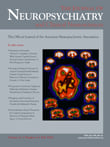Acute Depression and Suicidal Attempt Following Lowering the Frequency of Deep Brain Stimulation
To the Editor: Deep brain stimulation (DBS) is a neurosurgical intervention that enables deep brain structures to be stimulated electrically by an implanted pacemaker. 1 The method was initially developed for movement disorders in several target areas such as the thalamus, pallidum, and subthalamic nucleus. 2 It has now also been extended to other neuropsychiatric conditions and has shown some promising results in patients suffering from profound depression. 3
In depression, dysfunction of the limbic-cortico-striatal-pallidal-thalamic pathways has been proposed. 4 – 6 Although the exact mechanism of action of DBS remains elusive, stimulation of selected areas implicated in mood regulation may have therapeutic potential or lead to adverse consequences due to modulation of circuits related to depression. 5
Case Report
We report a case of a 66-year-old male who was diagnosed with Parkinson’s disease 20 years ago and was implanted with a subthalamic deep brain stimulation treatment system bilaterally for the last 8 years. He continued taking oral Parkinson’s disease medication. Subsequently, his dyskinesia and movements markedly improved. There were no psychiatric adverse events experienced following DBS implantation. Four years later, he developed a major depressive episode after his retirement and responded well to an adequate trial of bupropion. He did not report prior history of suicidal thoughts or attempts and followed up regularly with a psychiatrist.
Reportedly, for the last 5 years his neurologist had been changing the frequency of the brain stimulation through the implanted devices to negate the patient’s changing dyskinetic symptoms and disease progression. The frequency of the stimulation was lowered from 185 Hz to 60 Hz. Within 24 hours of lowering the frequency, the patient developed acute depression and made a serious suicide attempt by overdosing on sleeping pills. He was admitted to an intensive care unit and transferred to a psychiatric facility. His neurologist reportedly increased the frequency while the patient was in the hospital, and accordingly, his depressive feelings improved considerably over the next few days with complete remission of his suicidal thoughts.
Discussion
Several case reports have been published showing the potential of deep brain stimulation in the treatment of depression. 7 Our case demonstrates the risk of suicide when lowering the frequency of the stimulation. Patients undergoing an adjustment to the stimulation parameters according to their changing motor symptoms should be prescreened and assessed thoroughly for suicide risk prior to the changes. 7 Additionally, patients should be monitored closely for suicidal behavior after the changes. 7 Patients at high risk for suicide should be excluded from deep brain stimulation surgery. 8
1. Pereira EA, Green AL, Nandi D, et al: Deep brain stimulation: indications and evidence. Expert Rev Med Devices 2007; 4:591–603Google Scholar
2. Benabid AL: What the future holds for deep brain stimulation. Expert Rev Med Devices 2007; 4:895–903Google Scholar
3. Schlaepfer TE, Cohen MX, Frick C, et al: Deep brain stimulation to reward circuitry alleviates anhedonia in refractory major depression. Neuropsychopharmacology 2008; 33:368–377Google Scholar
4. Kopell BH, Greenberg BD: Anatomy and physiology of the basal ganglia: implications for DBS in psychiatry. Neurosci Biobehav Rev 2008; 32:408–422Google Scholar
5. Kosel M, Sturm V, Frick C, et al: Mood improvement after deep brain stimulation of the internal globus pallidus for tardive dyskinesia in a patient suffering from major depression. J Psychiatr Res 2007; 41:801–803Google Scholar
6. Kopell BH, Greenberg B, Rezai AR: Deep brain stimulation for psychiatric disorders. J Clin Neurophysiol 2004; 21:51–67Google Scholar
7. Appleby BS, Duggan PS, Regenberg A, et al: Psychiatric and neuropsychiatric adverse events associated with deep brain stimulation: a meta-analysis of ten years’ experience. Mov Disord 2007; 22:1722–1728Google Scholar
8. Burkhard PR, Vingerhoets FJ, Berney A, et al: Suicide after successful deep brain stimulation for movement disorders. Neurology 2004; 63:2170–2172Google Scholar



